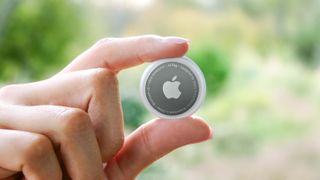Apple's Find My network can be used to steal data — here's how
Apple tree's Find My network can be used to steal information — hither's how

Y'all can use Apple's Detect My network to steal information from devices that aren't connected to the internet, a German researcher says.
Positive Security's Fabian Bräunlein found he could take data out of a device that had simply a Bluetooth connexion — essentially a homemade AirTag — and use iPhones and Macs to get the information all the way upwards into Apple tree's iCloud servers. From there, Braunlein could access the information from his own Mac.
- The best keyfinders right now
- Apple tree AirTag's anti-stalking features take a serious loophole
- Plus: Android 12 leak merely revealed a complete makeover for Google's OS
The whole process works very slowly. Bräunlein was getting a transmission rate of about 3 bytes per 2nd, and each chunk of data is a maximum of xvi bytes. But over fourth dimension, you could get a respectable corporeality of text transmitted. He'due south calling his system "Ship My."
The information theft works because each Bluetooth device on the Detect My network sends out a public encryption key to all nearby receiving Apple devices. Those devices marker their own locations, bundle it with the Bluetooth device'south public encryption key, and transport the resulting "location report" up to Apple'southward deject.
Bräunlein found a way to embed letters in the encryption keys in the location reports and hence communicate very short secret messages from his homemade AirTag through Apple tree'southward Find My network to his Mac.
Spying, tracking and messaging
The implications of Bräunlein'due south research aren't purely theoretical. Millions of computers worldwide are disconnected from the net for condom reasons because the computers hold highly sensitive information or run critically important processes, such equally coordinating the movements of trains or running ability plants.
"Such a technique could exist employed by small-scale sensors in uncontrolled environments to avoid the toll and power-consumption of mobile internet," Bräunlein wrote in a blog post, echoing what Amazon is already doing with its Sidewalk low-energy mesh network. "It could as well be interesting for exfiltrating information from Faraday-shielded sites that are occasionally visited by iPhone users."
If some of those computers could exist fabricated to communicate via Bluetooth with iPhones that come well-nigh, then data might be snuck out of — or snuck into — those machines.
Bräunlein didn't mention it, only information technology's already articulate that AirTags tin be used to secretly track people for upwards to three days earlier the AirTags will emit a chirp to reveal themselves. A bootleg AirTag might exist able to rails someone indefinitely without revealing its being.
How a homemade AirTag got onto Find My network
Apple tree's Notice My network is a giant mesh network made up of hundreds of millions of iPhones worldwide. Each iPhone listens for Bluetooth connections from other devices on the network, and if a Bluetooth-only device is sending out a circulate message, nearby iPhones will pick upward the bulletin and employ their cellular or Wi-Fi connections to relay the message to Apple'south cloud servers.
This system was originally meant to locate lost iPhones, iPads and MacBooks, just it's since been expanded to include other devices such as Belkin earbuds and VanMoof electric bikes.
Before this year, a bunch of German researchers (not including Bräunlein) figured out how to get other Bluetooth devices — ones not approved by Apple — onto the Notice My network.
Basically, they created their own AirTags earlier AirTags were appear. (The same researchers also demonstrated privacy flaws in AirDrop, which uses many of the same network protocols equally Notice My, and have created an Android app called AirGuard, which has been recommended by women concerned about AirTag-based stalking.)
They created a tool called OpenHaystack that piggybacks on the Find My network. I part is firmware that is loaded onto a tiny single-board computer such as a Raspberry Pi or something similar, which becomes the bootleg AirTag. The other part is a Mac desktop application and a Mail plugin that'southward necessary for the whole affair to work.
Bräunlein modified the OpenHaystack board firmware onto an ESP2 tiny single-lath estimator — his homemade AirTag — and the corresponding software onto his Mac. Using those tools, Bräunlein was able to not only rail the ESP2 using the Find My network, but as well use the Find My encryption protocol and location reports to transmit messages.
Can Apple tree end this?
Oddly enough, Apple may non be able to stop this kind of apply, or corruption, of its Notice My network. That'south because Discover My letters are encrypted end-to-end, and Apple can neither meet what'due south in those messages or what kind of devices are sending them.
"Apple does not know which public keys belong to your AirTag, and therefore which location reports were intended for you," Bräunlein wrote in his weblog post. "It would be hard for Apple to defend against this kind of misuse in case they wanted to."
Tom's Guide has reached out to Apple tree for comment, and nosotros will update this story when we get a response.
- More than: iPhone thirteen release appointment, specs, price and leaks
Source: https://www.tomsguide.com/news/apples-find-my-network-can-be-used-to-steal-data-heres-how
Posted by: schroeterstinin.blogspot.com


0 Response to "Apple's Find My network can be used to steal data — here's how"
Post a Comment